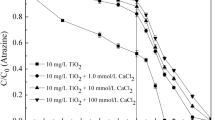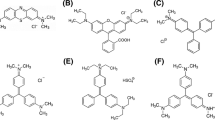Abstract
Introduction
Titanium dioxide (TiO2) nanoparticle powders have been extensively studied to quickly photodegrade some organic pollutants; however, the effect of the particle size of TiO2 nanoparticle aggregates on degradation remains unclear because microscale aggregates form once the nanoparticle powders enter into water.
Methods
The degradation of azo dye by different particle sizes of TiO2 nanoparticle aggregates controlled by NaCl concentrations was investigated to evaluate the particle size effect. Removal reactions of reactive black 5 (RB5) with TiO2 nanoparticles followed pseudo-first-order kinetics.
Results
The increase of TiO2 dosage from 40 to 70 mg/L enhanced the degradation. At doses around 100 mg/L TiO2, degradation rates decreased which could be the result of poor UV light transmittance at high-particle concentrations. At average particle sizes of TiO2 nanopowders less than around 500 nm, the degradation rates increased with decreasing particle size. As the average particle size exceeded 500 nm, the degradation rates were not significantly changed.
Conclusions
For the complete degradation experiments, the mineralization rates of total organic carbon disappearance are generally following the RB5 decolorization kinetic trend. These findings can facilitate the application of TiO2 nanoparticles to the design of photodegradation treatments for wastewater.






Similar content being viewed by others
References
Aguedach A, Brosillon S, Morvan J, Lhadi EK (2008) Influence of ionic strength in the adsorption and during photocatalysis of reactive black 5 azo dye on TiO2 coated on non woven paper with SiO2 as a binder. J Hazard Mater 150:250–256
Al-Degs YS, El-Barghouthi MI, El-Sheikh AH, Walker GM (2008) Effect of solution pH, ionic strength, and temperature on adsorption behavior of reactive dyes on activated carbon. Dyes Pigments 77:16–23
Almquist CB, Biswas P (2002) Role of synthesis method and particle size of nanostructured TiO2 on its photoactivity. J Catal 212:145–156
Bahorsky MS (1997) Textiles. War Environ Res 69:658–664
Bandara J, Mielczarski JA, Kiwi J (1999) 2. Photosensitized degradation of azo dyes on Fe, Ti, and Al oxides. mechanism of charge transfer during the degradation. Langmuir 15:7680–7687
Barka N, Qourzal S, Assabbane A, Nounah A, Ait-Ichou Y (2008) Factors influencing the photocatalytic degradation of rhodamine B by TiO2-coated non-woven paper. J Photoch Photobio A 195:346–351
Behnajady MA, Modirshahla N, Shokri M, Elham H, Zeininezhad A (2008) The effect of particle size and crystal structure of titanium dioxide nanoparticles on the photocatalytic properties. J Environ Sci Heal A 43:460–467
Bianco Prevot A, Baiocchi C, Brussino MC, Pramauro E, Savarino P, Augugliaro V, Marcì G, Palmisano L (2001) Photocatalytic degradation of acid blue 80 in aqueous solutions containing TiO2 suspensions. Environ Sci Techno 35:971–976
Curkovic L, Ljubas D, Juretic H (2010) Photocatalytic decolorization kinetics of diazo dye congo red aqueous solution by UV/TiO2 nanoparticles. React Kinet Mech Cat 99:201–208
Fan J, Guo YH, Wang JJ, Fan MH (2009) Rapid decolorization of azo dye methyl orange in aqueous solution by nanoscale zerovalent iron particles. J Hazard Mater 166:904–910
Hao WC (2002) Comparison of the photocatalytic activity of TiO2 powder with different particle size. J Mater Sci Lett 21:1807
He ZQ, Song S, Zhou HM, Ying HP, Chen JM (2007) CI reactive black 5 decolorization by combined sonolysis and ozonation. Ultrason Sonochem 14:298–304
Houas A, Lachheb H, Ksibi M, Elaloui E, Guillard C, Herrmann JM (2001) Photocatalytic degradation pathway of methylene blue in water. Appl Catal B-Environ 31:145–157
Ince NH, Gönenç DT (1997) Treatability of a textile azo dye by UV/H2O2. Environ Technol 18:179–185
Ince NH, Tezcanlí G (2001) Reactive dyestuff degradation by combined sonolysis and ozonation. Dyes Pigments 49:145–153
Jang HD, Kim SK, Kim SJ (2001) Effect of particle size and phase composition of titanium dioxide nanoparticles on the photocatalytic properties. J Nanopart Res 3:141–147
Jonstrup M, Kumar N, Murto M, Mattiasson B (2011) Sequential anaerobic–aerobic treatment of azo dyes: decolourisation and amine degradability. Desalination 280:339–346
Khataee AR, Pons MN, Zahraa O (2009) Photocatalytic degradation of three azo dyes using immobilized TiO2 nanoparticles on glass plates activated by UV light irradiation: influence of dye molecular structure. J Hazard Mater 168:451–457
Koci K, Obalova L, Matejova L, Placha D, Lacny Z, Jirkovsky J, Solcova O (2009) Effect of TiO2 particle size on the photocatalytic reduction of CO2. Appl Catal B-Environ 89:494–502
Krajangpan S, Jarabek L, Jepperson J, Chisholm B, Bezbaruah A (2008) Polymer modified iron nanoparticles for environmental remediation, pp. 921–922
Kritikos DE, Xekoukoulotakis NP, Psillakis E, Mantzavinos D (2007) Photocatalytic degradation of reactive black 5 in aqueous solutions: effect of operating conditions and coupling with ultrasound irradiation. Water Res 41:2236–2246
Krysa J, Keppert M, Jirkovsky J, Stengl V, Subrt J (2004) The effect of thermal treatment on the properties of TiO2 photocatalyst. Mater Chem Phys 86:333–339
Lin H, Huang CP, Li W, Ni C, Shah SI, Tseng YH (2006) Size dependency of nanocrystalline TiO2 on its optical property and photocatalytic reactivity exemplified by 2-chlorophenol. Appl Catal B-Environ 68:1–11
Maira AJ, Yeung KL, Lee CY, Yue PL, Chan CK (2000) Size effects in gas-phase photo-oxidation of trichloroethylene using nanometer-sized TiO2 catalysts. J Catal 192:185–196
Mollah MYA, Morkovsky P, Gomes JAG, Kesmez M, Parga J, Cocke DL (2004) Fundamentals, present and future perspectives of electrocoagulation. J Hazard Mater 114:199–210
Murugesan S, Kuppusami P, Mohandas E (2010) Rietveld X-ray diffraction analysis of nanostructured rutile films of titania prepared by pulsed laser deposition. Mater Res Bull 45:6–9
Nikazar M, Gholivand K, Mahanpoor K (2008) Photocatalytic degradation of azo dye acid red 114 in water with TiO2 supported on clinoptilolite as a catalyst. Desalination 219:293–300
Ogutveren UB, Koparal S (1994) Color removal from textile effluents by electrochemical destruction. J Environ Sci Health A Tox Hazard Subst Environ Eng 29:1–16
Pelegrini R, Peralta-Zamora P, De Andrade AR, Reyes J, Durán N (1999) Electrochemically assisted photocatalytic degradation of reactive dyes. Appl Catal B-Environ 22:83–90
Raghavacharya C (1997) Colour removal from industrial effluents—a comparative review of available technologies. Chem Eng World 32:53–54
Rajkumar D, Kim JG (2006) Oxidation of various reactive dyes with in situ electro-generated active chlorine for textile dyeing industry wastewater treatment. J Hazard Mater 136:203–212
Rao VVB, Rao SRM (2006) Adsorption studies on treatment of textile dyeing industrial effluent by flyash. Chem Eng J 116:77–84
Rao KCLN, Krishnaiah K, Ashutosh (1994) Colour removal from a dyestuff industry effluent using activated carbon. Indian J Chem Techn 1:13–19
Reutergardh LB, Iangphasuk M (1997) Photocatalytic decolourization of reactive azo dye: a comparison between TiO2 and CdS photocatalysis. Chemosphere 35:585–596
Saratale RG, Saratale GD, Kalyani DC, Chang JS, Govindwar SP (2009) Enhanced decolorization and biodegradation of textile azo dye Scarlet R by using developed microbial consortium-GR. Bioresource Technol 100:2493–2500
Sivalingam G, Nagaveni K, Hegde MS, Madras G (2003) Photocatalytic degradation of various dyes by combustion synthesized nano anatase TiO2. Appl Catal B-Environ 45:23–38
Slokar YM, Majcen Le Marechal A (1998) Methods of decoloration of textile wastewaters. Dyes Pigments 37:335–356
Tanaka K, Padermpole K, Hisanaga T (2000) Photocatalytic degradation of commercial azo dyes. Water Res 34:327–333
Tso CP, Zhung CM, Shih YH, Tseng YM, Wu SC, Doong RA (2010) Stability of metal oxide nanoparticles in aqueous solutions. Water Sci Technol 61:127–133
Ullrich S, Karrasch B, Hoppe H, Jeskulke K, Mehrens M (1996) Toxic effects on bacterial metabolism of the redox dye 5-cyano-2,3-ditolyl tetrazolium chloride. Appl Environ Microb 62:4587–4593
Wang KH, Hsieh YH, Wu CH, Chang CY (2000) The pH and anion effects on the heterogeneous photocatalytic degradation of o-methylbenzoic acid in TiO2 aqueous suspension. Chemosphere 40:389–394
Zhang ZB, Wang CC, Zakaria R, Ying JY (1998) Role of particle size in nanocrystalline TiO2-based photocatalysts. J Phys Chem B 102:10871–10878
Zhu HY, Orthman JA, Li JY, Zhao JC, Churchman GJ, Vansant EF (2002) Novel composites of TiO2 (anatase) and silicate nanoparticles. Chem Mater 14:5037–5044
Acknowledgments
The authors gratefully acknowledge the financial support of the National Science Council of Taiwan, R.O.C.
Author information
Authors and Affiliations
Corresponding author
Additional information
Responsible editor: Philippe Garrigues
Electronic supplementary material
Below is the link to the electronic supplementary material.
Fig. S1
Structure of RB5 (DOCX 27 kb)
Fig. S2
Schematic diagram of photochemical apparatus (DOCX 28 kb)
Fig. S3
DLS analysis of 40 mg/L TiO2 nanoparticles with and without ultrasonication (DOCX 22 kb)
Fig. S4
The XRD pattern of TiO2 nanoparticles (DOCX 195 kb)
Fig. S5
The particle size change of TiO2 nanoparticle powder with time: (a) average particle size change with time by DLS, the number in parentheses means the average, (b) particle size distribution with time by DLS, up left picture for 40 meq/L, and (c) particle size observed by TEM (DOCX 644 kb)
Fig. S6
The sorption of RB5 on TiO2 nanoparticle aggregates with different particle size. The number in parentheses means average particle size (DOCX 165 kb)
Rights and permissions
About this article
Cite this article
Shih, Yh., Lin, Ch. Effect of particle size of titanium dioxide nanoparticle aggregates on the degradation of one azo dye. Environ Sci Pollut Res 19, 1652–1658 (2012). https://doi.org/10.1007/s11356-011-0669-z
Received:
Accepted:
Published:
Issue Date:
DOI: https://doi.org/10.1007/s11356-011-0669-z




